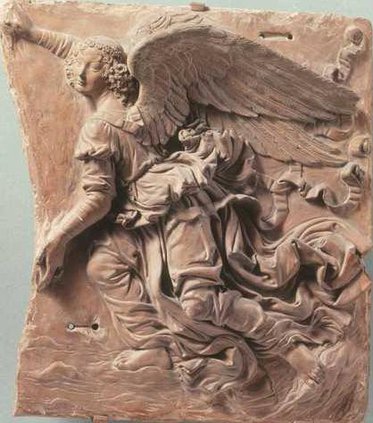ATLANTA — Leonardo da Vinci once spent nearly two decades creating a 26-foot (8-meter) sculpture of a horse to honor a royal Italian family, only to have the plaster masterpiece destroyed by French soldiers.
The Italian artist best known for his paintings and inventions rather than sculpting abilities created more than a dozen sculptures in his lifetime, many of which have disappeared.
A rare U.S. exhibit of the remaining few sculptures and dozens of sketches by da Vinci and his contemporaries will open Tuesday at Atlanta's High Museum of Art, featuring art never seen outside of Europe.
The exhibit will remain in Atlanta until February, when a modified version will travel to the J. Paul Getty Museum in Los Angeles. It includes pieces from the Vatican's art collection, the Louvre in Paris and the royal collection at Windsor Castle in England.
"One of the marketing lines that fell on the cutting room floor was, 'Approved by the queen and blessed by the Pope,'" said the museum's deputy director, Philip Verre.
The centerpiece is a nearly 30-foot (9-meter) recreation of da Vinci's destroyed horse statue, which towers over the plaza outside the High. Inside the museum are the meticulous drawings and anatomical notes he made of the Sforza family's horses in hopes of perfectly capturing the animals' motion.
He even mapped out the machines he needed to invent to cover the giant plaster horse in bronze and how to transport it once it was completed. Those plans never came to fruition, though, because the bronze intended for the statue was used to make cannons for a war with France. When the French army invaded Milan, the plaster horse was destroyed by soldiers.
The exhibit also includes three pieces believed to have been sculpted in part by da Vinci, though his name was never put on any of them, said exhibit curator Gary Radke, a Syracuse University humanities professor. Those are a silver sculptured panel depicting the beheading of John the Baptist, a small bronze horse and a terra-cotta angel relief.
"These are just drop-dead gorgeous," Radke said during a tour of the exhibit Wednesday. "For me, it is a real joy to help people see that Leonardo was a student of sculpture as well as a master sculptor himself."
The exhibit also features a marble statue of a bearded prophet by Donatello, the first time a life-size sculpture by the artist has ever visited the U.S. It also includes three bronze statues of John the Baptist preaching to a Levite and a Pharisee by Giovanni Francesco Rustici, a student of da Vinci who was influenced by his teacher's work.
The Italian artist best known for his paintings and inventions rather than sculpting abilities created more than a dozen sculptures in his lifetime, many of which have disappeared.
A rare U.S. exhibit of the remaining few sculptures and dozens of sketches by da Vinci and his contemporaries will open Tuesday at Atlanta's High Museum of Art, featuring art never seen outside of Europe.
The exhibit will remain in Atlanta until February, when a modified version will travel to the J. Paul Getty Museum in Los Angeles. It includes pieces from the Vatican's art collection, the Louvre in Paris and the royal collection at Windsor Castle in England.
"One of the marketing lines that fell on the cutting room floor was, 'Approved by the queen and blessed by the Pope,'" said the museum's deputy director, Philip Verre.
The centerpiece is a nearly 30-foot (9-meter) recreation of da Vinci's destroyed horse statue, which towers over the plaza outside the High. Inside the museum are the meticulous drawings and anatomical notes he made of the Sforza family's horses in hopes of perfectly capturing the animals' motion.
He even mapped out the machines he needed to invent to cover the giant plaster horse in bronze and how to transport it once it was completed. Those plans never came to fruition, though, because the bronze intended for the statue was used to make cannons for a war with France. When the French army invaded Milan, the plaster horse was destroyed by soldiers.
The exhibit also includes three pieces believed to have been sculpted in part by da Vinci, though his name was never put on any of them, said exhibit curator Gary Radke, a Syracuse University humanities professor. Those are a silver sculptured panel depicting the beheading of John the Baptist, a small bronze horse and a terra-cotta angel relief.
"These are just drop-dead gorgeous," Radke said during a tour of the exhibit Wednesday. "For me, it is a real joy to help people see that Leonardo was a student of sculpture as well as a master sculptor himself."
The exhibit also features a marble statue of a bearded prophet by Donatello, the first time a life-size sculpture by the artist has ever visited the U.S. It also includes three bronze statues of John the Baptist preaching to a Levite and a Pharisee by Giovanni Francesco Rustici, a student of da Vinci who was influenced by his teacher's work.

